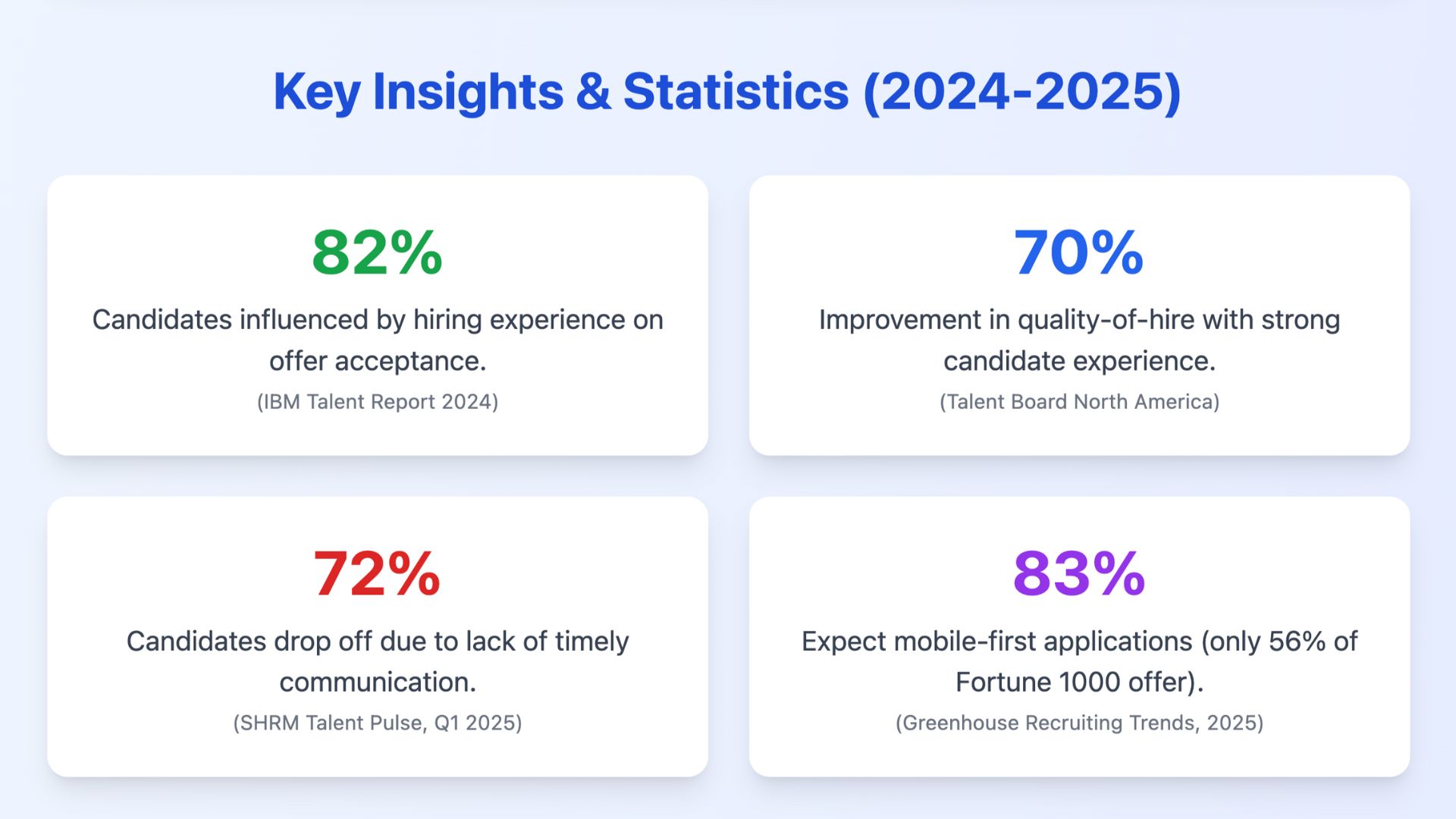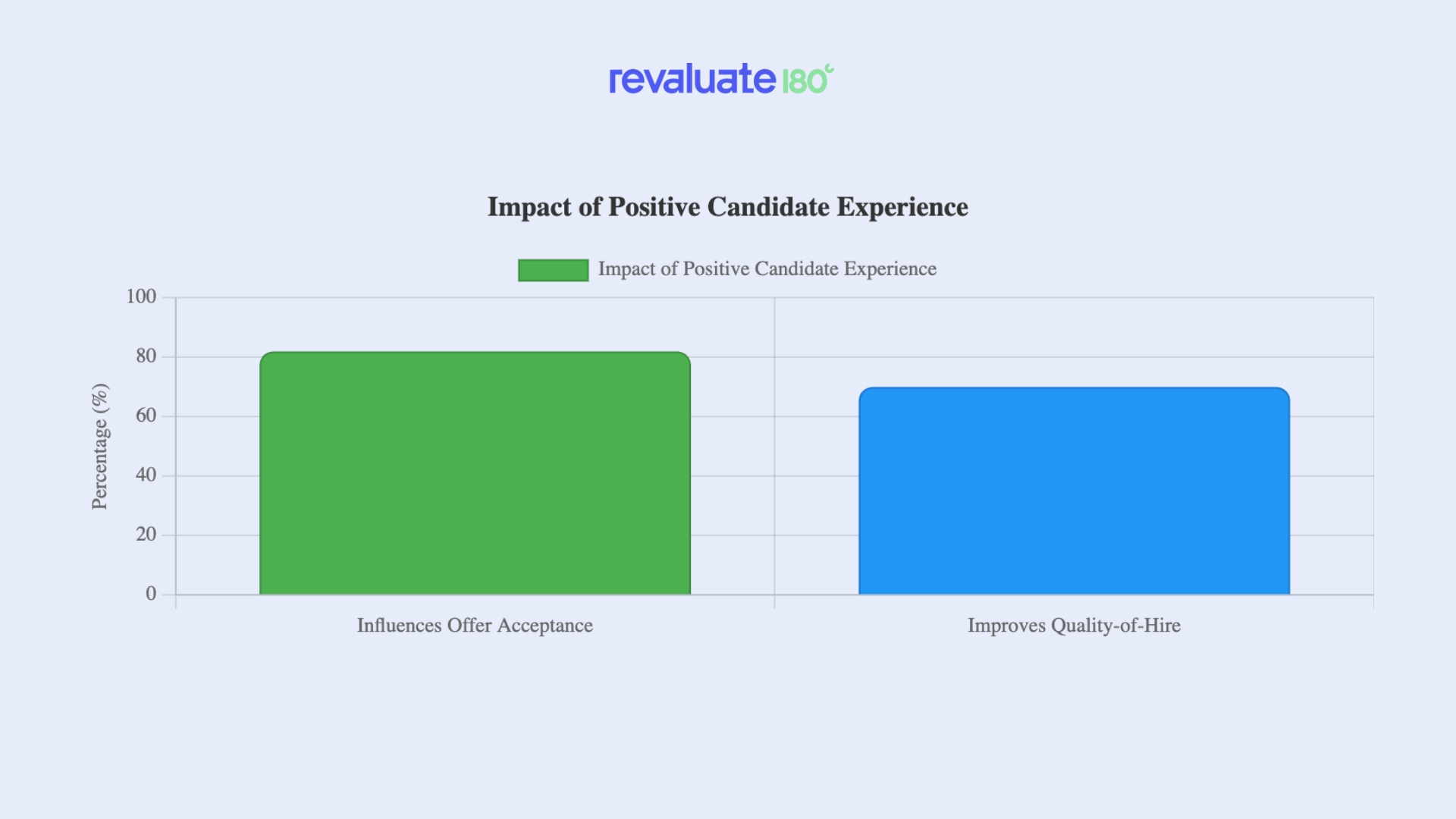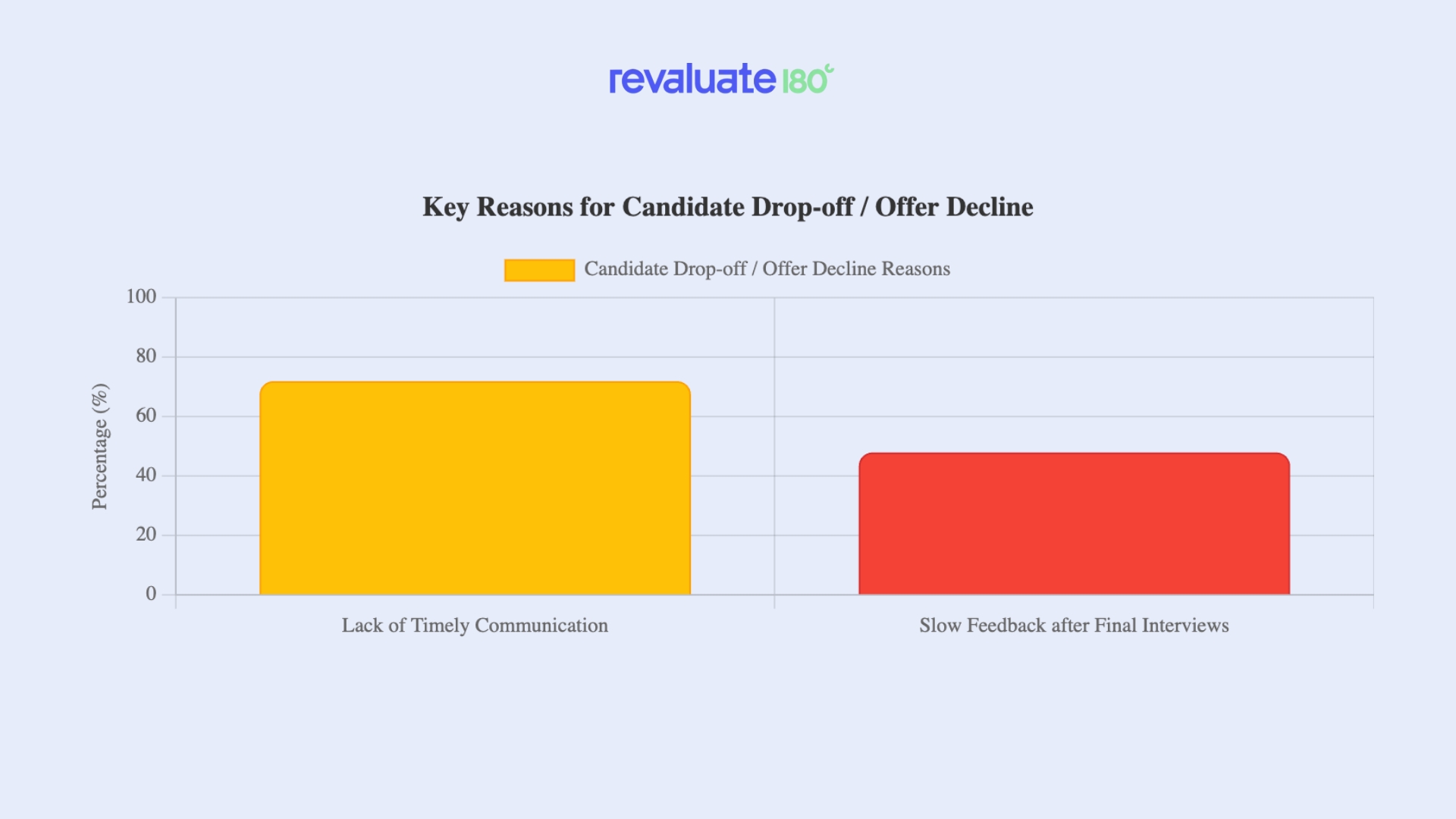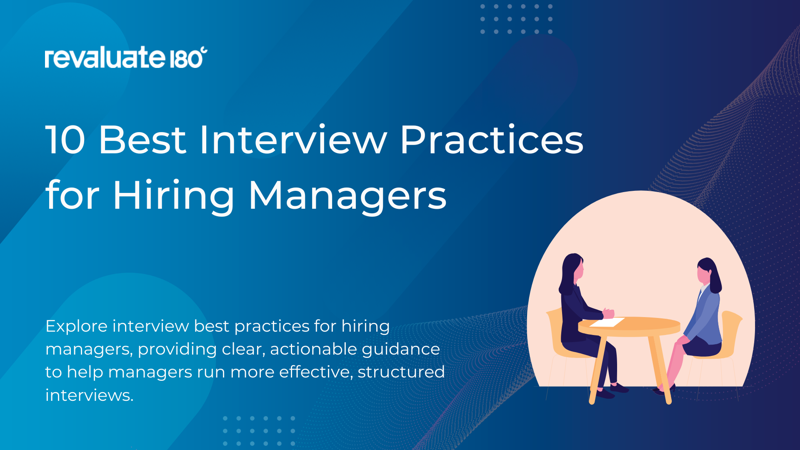Although hiring decisions significantly impact everything from your team’s performance to your company culture, interviews often rely on gut instincts or outdated practices that fail to predict long-term growth within the organization.
With today’s competitive job market and increasing emphasis on diversity, value alignment, and candidate experience, hiring managers are required to be more intentional than before. This article breaks down the 10 best interview practices to help eliminate guesswork and bias from the process, improving candidate fit and enhancing engagement. So, let’s dive in!
Key Takeaways
It’s all about hiring the right talent that goes beyond asking the right questions. The 10 best interview practices for hiring managers focus on creating a structured, inclusive, and data-driven interview process. This article highlights how these qualities can be evaluated through candidate experience, bias reduction programs, and informed decision-making based on data.
From structured interview formats and clear evaluation criteria to real-time behavioral analysis from platforms like Revaluate180, these strategies are designed to help you hire smarter, faster, and better every time.

1. Clarify the Role and Ideal Candidate Profile
A hiring manager must clearly understand the specific skills and qualities required before conducting an interview. Defining the role's core requirements and success metrics, including the other technical skills and experience, is crucial.
You must preserve your company culture at all costs. If you’re in the stage of cultivating a workplace culture, you must know that the candidates are also looking at your company culture before choosing your company. Therefore, you must write a clear and compelling job description that sets accurate candidate expectations. Since it’s reported that candidates leave in the first six months if their expectations don’t match the job descriptions, we highly recommend assessing and rewriting your descriptions as needed.
When both you and the candidates can understand what success looks like, interviews become more efficient. You can bring a simple checklist to each interview and note the competencies as they come up. This way, you’ll avoid any vague impressions and decisions based on your instincts. Listing what you want will help you find the right person to contribute to and grow with the team.
2. Structure Your Interview Process
Structure and consistency are foundational to the ethical and unbiased hiring process. That’s why it's essential to design a standardized interview process with the same interview stages, question formats, and exercises for all candidates applying to the same vacancy.
Now that we have standardized the hiring criteria, we can conduct constant interviews and evaluate all candidates using the same criteria to ensure fairness across all hiring stages. Standardization also helps mitigate unconscious bias and makes comparisons more meaningful.
Scheduling is part of the structure. Set clear timelines and communicate them whenever needed. This not only helps you stay on time but also reflects your company culture to the candidates. The average time-to-hire is around 40 days, but long delays risk losing the potential talent. You don’t want that, since the cost of losing an employee is significant, equivalent to six months’ salary. A predictable and transparent process will give you a positive experience.
3. Know What You’re Looking For: Skills, Traits, and Culture Fit
Good hiring managers can easily distinguish between hard skills, soft skills, and cultural traits in potential candidates. Hard skills, such as coding or accounting, are meticulously tested, while soft skills, including communication and collaboration, are typically assessed through general one-on-one conversations.
While using job descriptions to identify the core technical skills mentioned above will give you a clear understanding, defining the core competencies and traits aligned with your team’s culture will help you shortlist the right candidates. Suppose your team’s success relies on creativity and agility; tag ‘innovative problem solving’ as a must-have competency in the requirements section.
Consider creating a candidate scoreboard where you can list these traits in advance to shortlist candidates that you feel are the right fit for this role. Remember, companies with a strong cultural fitness will tend to see lower turnover because candidates who are aligned with the values will stay longer.
4. Create a Positive Candidate Experience

A straightforward and respectful interview process will reflect well on your company and help you secure the best talent in the industry. Statistics show that 82% of candidates say a good hiring experience influences their decision to accept an offer. If you don’t follow up, they’re likely to drop off due to a lack of communication. Therefore, set clear expectations before the interview and inform the candidates who they’re meeting, how long the process will be, and when you’ll likely follow up with them.

This way, you’ll treat candidates as guests while being straightforward with the process, letting them know you have more to offer if they’re willing to join your company. A study by Google even found that candidates rejected after structured interviews were 35% happier with the experience than those who went through the unstructured ones.
5. Ask the Right Questions the Right Way
Asking the right questions is half the battle since the quality of your questions directly affects what you conceive. Use open-ended questions that allow candidates to share details. For example, ask them when they solved a particular problem, rather than just asking yes/no questions.
Emphasize questions based on behavior and situations likely to predict the candidate’s future performance. One study by Vorecol found that 91% of employers use behavioral questions, and companies with this strategy saw a 39% reduction in turnover compared to the traditional methods.
If adaptability is vital for this role, ask about how they handle change or uncertainty in situations. Additionally, follow up on interesting points to dig deeper. This is the only way to uncover a candidate’s full potential.

Unlock AI-Powered Hiring Analytics
Transform the way you hire with insights that create aligned, collaborative, and high-performing teams.
 Smarter Hiring Decisions
Smarter Hiring Decisions
 Reduce Expensive Turnover
Reduce Expensive Turnover
 AI-Driven Insights
AI-Driven Insights
 Optimize Team Performance
Optimize Team Performance

6. Practice Active Listening and Observation
If asking questions is one side of the coin, active listening is the other. Strive for an 80/20 balance, where you spend 80% of the time listening to the candidates and 20% talking and reflecting on what has been discussed. Doing this will give candidates room to speak fully. Active listening techniques include nodding, summarizing their points, and asking clear questions.
If you believe the point hasn’t been made yet, you can observe the nonverbal cues such as their body language, energy level, and even their tone of voice. For example, does the candidate maintain reasonable eye contact? Do they sit up straight? Or do they seem disengaged? This can reveal their confidence, enthusiasm, or nervousness. Finally, your goal is to hear what they have to offer and not just deliver your sales pitch.
7. Avoid Common Interview Mistakes
Hiring managers must be vigilant against pitfalls that are highly detrimental to an effective interview. Bias is chief among these. Research shows that nearly 59.9% of decisions were made within the first 15 minutes of the interview process. Therefore, it’s crucial not to fall for the first-impression bias.
Overcoming this first-impression bias will get easier if you stick to your structured process and scoreboards. That’s why standardizing the interview process is vital, as you no longer have to depend on first impressions.
Other mistakes include questions such as “You work well under pressure, right?” These push candidates towards the answer you expect rather than an honest response. Likewise, avoid talking too much to yourself. Stay mindful, adhere to the objective criteria, stay neutral, and keep candidates engaged.
8. Use Scorecards or Structured Assessment Criteria
Ethical evaluation is crucial to shortlisting the potential candidates, so using a written scorecard or rubric is essential. Before starting the interview, list the criteria in terms of skills, traits, cultural add, and culture fit to assign a simple rating for each candidate.
This ensures that every candidate is judged on the same factors, as the scoreboards are constructed directly in alignment with the job descriptions. This way, every candidate is judged on equal grounds. For example, rate candidates on a scale of 1 to 5 regarding team leadership, technical proficiency, problem-solving, and culture fit, with clear definitions for each score they adhere to.
Using scoreboards forces you to document your impressions immediately after each interview. This highlights the differences between interviewers and prompts valuable discussions. This can significantly reduce subjective bias, enabling you to make informed decisions and hire the right candidate.
9. Assess Both Skill and Culture Alignment
When evaluating candidates, strike a balance between technical and cultural fit. If the candidate has the perfect skill set but lacks the team’s work style, ask yourself if they can bring a different perspective to the table and contribute to your culture, rather than just being a good fit. This can make or break your company.
Conversely, a strong culture fit with a growth mindset may outperform a technically superior one, but may lack the engagement necessary to maintain collective productivity. To judge this balance, weigh each candidate’s skill strengths alongside your values and team dynamics.
Additionally, be aware of red flags. For example, a history of frequent job changes might indicate a poor culture fit or a lack of serious commitment. However, it’s equally important to note that a candidate lacking one skill can quickly acquire it if other attributes are well-aligned.
10. Post-Interview Steps Matter

Your interview process doesn’t end when the candidate leaves the room. A clear follow-up and team communication are as crucial as the interview. Immediately after each interview, try to summarize the impressions while they’re fresh and use your notes and scoreboards to draft candidate reports.
After carefully assessing the candidate, debrief with the hiring team on the same day and discuss everyone’s ratings to decide on the next steps together. This mitigates momentum loss, ensuring that every decision is made collectively and promptly.
Communicate feedback in a timely manner. It’ll show you care regardless of their selection. If a candidate is no longer under consideration, send a brief thank-you message and a rejection notice.
While feedback is optional, it’s highly appreciated, as many hiring managers tend to skip rejections. Studies show that 45% of candidates experienced ghosting by recruiters. Therefore, maintaining clear communication can prevent damage to your work culture’s reputation.
Tips for Remote and Hybrid Hiring
While remote work has become more common since 2020 (after COVID), hiring managers must adapt these best practices regardless of the location. Here are a few things you must remember:
- Use Globally Recognized Video Platform: Starting with reliable tools and technology, using a stable video platform that everyone on the panel is comfortable with is foundational to building a strong remote workforce.
- Always Test Technology in Advance: Have an essential backup contact in case someone’s video fails during a meeting. Good audio and a neutral background are crucial, so consider advising candidates to do the same to demonstrate professionalism.
- Maintain the Etiquette: There’s a difference between in-person interviews and remote interviews, so you must maintain etiquette and eye contact through your proactive behavior and by looking directly at the camera, rather than at the screen.
- Reduce Distractions: You can reduce distractions during the interview by closing any unnecessary apps, turning your phone off, and finding a quiet place to talk.
- Speak What You Observe: Since body language at the start will give away the first impression and structure to your interviews, benefit from it by speaking up more about what you observe. For instance, say, “I noticed you lit up when talking about X; tell me more about it!” Doing this makes them feel heard and keeps the conversation flowing.
- Be Patient With the Pauses: Video lag or nervousness can cause a candidate to take a moment to answer. Therefore, allow them time for their responses and encourage questions by frequently pausing and asking if there are any questions after going through a specific topic.
Finally, remember that remote processes should prioritize candidate comfort over their availability at all costs. You can consider starting the call a couple of minutes earlier to chat casually, just as you’d offer someone coffee if they were at the office. These small but significant steps make remote candidates feel welcomed and can improve their overall hiring experience.
How Revaluate180 Supports Smarter, Data-Driven Hiring Decisions
Beyond these human-centered practices, modern hiring is increasingly data-driven, and we have a good reason behind it. Revaluate180 is your solution to deeper insights, as our model analyzes candidates’ values, true motivations, and likely future growth, not just their resume and interview performance.
We avoid costly hiring mistakes by analyzing candidates’ alignment with specific roles and teams to ensure which potential candidates are likely to thrive in the long run in the given role and team environment. We produce a value profile for each candidate, measuring their alignment with your organization’s values and culture. These complement your subjective impression of culture fit with quantitative data-driven strategies. Contact us today to identify potential blind spots and supercharge your hiring process.
Final Thoughts
Interviewing is both an art and a science. By preparing carefully, listening actively, and utilizing structured techniques, hiring managers can significantly improve the quality of hires. These top 10 interview best practices, from clarifying roles to asking the right questions, reduce subjective bias while maintaining an inclusive environment for all. Remember that every step reflects on your employer’s brand, including the post-interview stage.
Incorporating practical data-driven tools alongside these practices will ensure that you evaluate both the resume and the person behind it. Evaluate with Revaluate180 to ultimately hire people who perform and stay engaged at work. Implementing these strategies will help you create teams comprised of talented employees who work well together and drive long-term organizational success.

Unlock AI-Powered Hiring Analytics
Transform the way you hire with insights that create aligned, collaborative, and high-performing teams.
 Smarter Hiring Decisions
Smarter Hiring Decisions
 Reduce Expensive Turnover
Reduce Expensive Turnover
 AI-Driven Insights
AI-Driven Insights
 Optimize Team Performance
Optimize Team Performance

FAQs
What are the 5 C’s of interviewing?
The five C’s of interviewing are Confidence, Competence, Communication, Character, and Chemistry, also known as Cultural Fitness. From self-assurance and skills to integrity and alignment with the company, these traits are foundational for candidate evaluation.
How to do well in a hiring manager interview?
Be well-prepared and role-specific in your research. Review the job description, and have concrete examples ready to match the required skills. Demonstrate your understanding of the team’s requirements by aligning your experience and asking as many relevant questions as possible regarding the position.
What are the 5 P’s of an interview?
The 5 P’s are often cited as Purpose, Preparation, Practice, Presentation, and Performance. These are collectively responsible for happening, preparing, rehearsing questions, presenting yourself, and answering the questions confidently.
What is the 30-60-90 question in an interview?
This question asks how you would approach the first 30, 60, and 90 days on the job. It urges you to plan long-term, outlining specific goals for each time bracket. This demonstrates how you will contribute quickly and strategically over time, proving your worthiness for the position.
